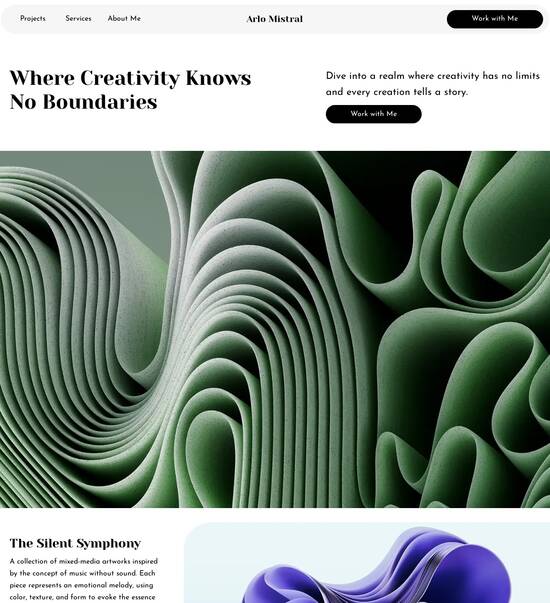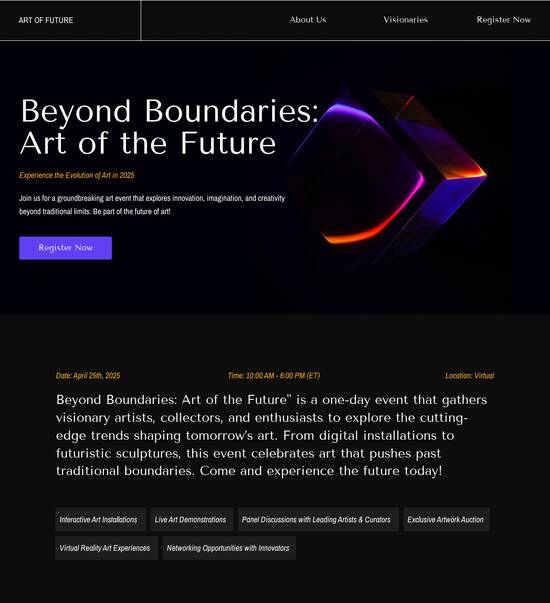
Product page template for Java developers
Explore Similar TemplatesAbout template
Master your online marketing with this builder for product page template for Java developers. Try more tools to create an immaculate landing page.
Recommended templates

Easy to build without coding
With the intuitive drag-and-drop builder, anyone on your team can create high-converting pages without any knowledge of code or design. Make enhancements to your landing page with custom widgets using Javascript, HTML/CSS, or third-party scripts.

Multiple layouts for any industry and goal
Select from 500+ landing page layouts built to boost conversions across industry-specific scenarios. Customize them by adjusting fonts, adding images, and generating on-brand content with the AI assistant. Quickly scale with Instablocks® and Global Blocks that you can save, reuse, and update globally.

Loads fast and looks polished on any device
Every template is responsive, which means they present professionally on any device and load blazingly fast with our Thor Render Engine. You can also power them up with Google AMP technology to deliver an unparalleled mobile experience and drive higher conversions.

Robust analytics & experimentation
Get real-time updates and reporting across all your devices, showing the number of visitors, conversions, cost-per-visitor, and cost-per-lead. Launch AI-powered experiments, run A/B tests, and use heatmaps to analyze user behavior, then optimize your landing page to maximize conversions.







Easy to build without coding
With the intuitive drag-and-drop builder, anyone on your team can create high-converting pages without any knowledge of code or design. Make enhancements to your landing page with custom widgets using Javascript, HTML/CSS, or third-party scripts.
Multiple layouts for any industry and goal
Select from 500+ landing page layouts built to boost conversions across industry-specific scenarios. Customize them by adjusting fonts, adding images, and generating on-brand content with the AI assistant. Quickly scale with Instablocks® and Global Blocks that you can save, reuse, and update globally.
Loads fast and looks polished on any device
Every template is responsive, which means they present professionally on any device and load blazingly fast with our Thor Render Engine.
Robust analytics & experimentation
Get real-time updates and reporting across all your devices, showing the number of visitors, conversions, cost-per-visitor, and cost-per-lead. Launch AI-powered experiments, run A/B tests, and use heatmaps to analyze user behavior, then optimize your landing page to maximize conversions.
All the features you need to build lead-generating landing pages
Explore more featuresLearn how to build top-performing landing pages for any goal
FAQs
Leading the way in building high-performing landing pages





Unlocking the potential of Instapage for landing page success
Creating effective landing pages is crucial for optimizing digital marketing strategies. Instapage serves as an all-in-one solution that empowers marketers to effortlessly generate high-converting landing pages tailored for diverse audiences in the USA. This guide will walk you through the step-by-step process of leveraging Instapage to boost your campaign's ROI.
Understanding Instapage’s core features
Instapage is designed to simplify complex landing page creation, making it accessible for any team size. Its flexible page builder, combined with a vast library of conversion-focused templates, means you can create compelling pages without needing technical skills. Each feature is aimed at maximizing engagement and lead capture.
- Customizable templates: Choose from over 100 pre-designed templates that can be adjusted to suit your branding and objectives.
- Dynamic text replacement: Tailor your messaging to match ad campaigns and audience segments, enhancing personalization and relevance.
- Analytics and A/B testing: Use data-driven insights to test different variations of your landing page, ultimately optimizing for better conversions.
Step 1: Setting up your first landing page
To get started with Instapage, follow these simple steps:
- Sign up for an Instapage account: Begin by creating an account and selecting a plan that fits your budget and business scale.
- Choose a template: Browse the extensive library of landing page templates and select one that aligns with your campaign goals.
- Customize your page: Use the intuitive drag-and-drop builder to modify text, images, and layout to fit your messaging.
Step 2: Optimize your landing page design
Optimization is key to maximizing your conversion rates. Let's explore some strategies:
- Utilize heatmaps: Analyze user behavior on your page to see where visitors are clicking and engaging.
- Conduct A/B tests: Experiment with different headlines, calls-to-action, and images to identify the most effective combination.
- Implement personalization features: Leverage Instapage's dynamic text replacement to create tailored experiences for specific audience segments.
Step 3: Collaborate and iterate continuously
Collaboration can streamline the creation process and improve final output. Keep in mind these best practices:
- Share pages securely: Instapage allows you to share your pages with team members or clients for feedback easily.
- Provide instant feedback: Utilize real-time editing features to discuss suggestions and make changes on the fly.
- Monitor analytics: Regularly review your landing page performance to make necessary adjustments based on user engagement.
In conclusion, leveraging the powerful tools provided by Instapage can significantly enhance your landing page effectiveness, driving better results for your marketing campaigns.
Ready to supercharge your landing pages? Sign up for Instapage today and experience the difference with our intuitive platform.
Unpacking the product page template for Java developers: A gateway to efficient page creation
Exploring the essence of product page templates
Product page templates serve as the backbone for Java developers aiming to create organized and efficient web applications. These templates provide a structured approach, allowing developers to focus on functionality and content rather than starting from scratch with design. By leveraging predefined templates, developers can ensure that their applications remain consistent, both visually and functionally. This is particularly relevant in e-commerce and product display scenarios, where user experience and aesthetics play critical roles.
The importance of templating structures in Java web applications cannot be overstated. Templates not only streamline the development process but also enhance maintainability and scalability. Changing a single template can propagate updates across multiple pages, saving time and reducing errors. This is particularly useful in larger applications where multiple developers might work concurrently. Overall, adopting a templated approach fosters a more collaborative and efficient coding environment.
Enhanced consistency across pages.
Faster development cycles.
Simplified maintenance and updates.
Improved collaboration among developers.
The power of location-based customization
As consumer preferences evolve, delivering dynamic content based on user location has become increasingly important. Java product page templates can be configured to respond to geographical data, allowing developers to create personalized experiences for customers. For instance, utilizing geolocation, a page could feature region-specific promotions, language preferences, or even stock availability, thereby enhancing the relevance of the user experience.
Implementing location services within Java templates typically involves leveraging libraries that can capture users' geographical data. Developers might use APIs to access location attributes and employ them for content delivery. Integration with services like Google Maps or location-based querying can facilitate this. This capability not only adds value but can significantly uplift customer satisfaction, particularly through offerings tailored to local preferences.
Responsive layouts based on location.
Localized promotions and offers.
Cultural context adjustments in presentations.
Relevance in product suggestions.
Modular design and innovative layouts
A modular design approach allows for flexibility and adaptability in product page layouts. Java developers can utilize various layout options, such as grid and flexbox layouts, to showcase products in a visually appealing manner. Grids tend to work well for displaying a large number of items, making them ideal for e-commerce platforms, while flexbox aids in rearranging elements dynamically based on screen size.
Best practices suggest that developers should carefully consider the types of products they are displaying to choose the most effective layout. For instance, a fashion retailer may prefer a grid layout to showcase diverse clothing options side by side, while a technology company may choose a flexbox layout to highlight product specifications more prominently. Ensuring that these layouts maintain a responsive design is crucial for accommodating users across various devices.
Grid layouts for a compact display of products.
Flexbox layouts for flexible and adaptable structures.
Incorporative designs that showcase featured products separately.
User-centric arrangements that prioritize critical information.
Feature-rich enhancements to boost performance
For Java product pages, including essential features can significantly affect performance and user engagement. Key functionalities to consider while developing templates might include integration with payment gateways, customer reviews, and real-time inventory updates. These features not only bolster user confidence but also enhance the overall shopping experience by providing vital information at the right moments.
Additionally, implementing user-driven features based on community feedback can lead to broader acceptance and seamless interactivity. Features such as wish lists, product comparisons, and social sharing options should be prioritized, as they enhance the interactivity of the product page, making users more inclined to engage. Encouraging feedback through surveys or developer forums can yield insights that direct feature enhancements more effectively.
Payment gateway integration.
Customer reviews and ratings.
Real-time inventory updates.
Social sharing capabilities.
Utilizing previews for optimal design approaches
The ability to preview product pages before final deployment is an invaluable aspect of the development process. Previews allow developers to iterate on designs swiftly, testing different layouts, color schemes, and contents without affecting the live product. This helps ensure that the final product meets user expectations and functions seamlessly within the application. Java environments come equipped with various tools that accommodate real-time previews, enabling instant feedback and adjustments.
Strategies for incorporating user feedback during the preview stage are crucial to iterative design development. Developers can create prototype templates and share them with a select group of users to gather insights on usability and aesthetic appeal. Continuous documentation of feedback can lead to informed decisions during template modifications, allowing for a more user-focused design process that accommodates both developer needs and customer expectations.
Real-time preview tools integration.
User feedback collection strategies.
Iterative testing cycles for design optimization.
Documenting feedback for future reference.
The role of collectives in Java development
Building a culture of collaboration within developer communities can bring significant enhancements to product page offerings. Developer collectives provide a platform for talent sharing, knowledge transfers, and collaborative problem-solving. By pooling resources and expertise, developers can continuously improve templates and keep them current with emerging trends and best practices.
Encouraging knowledge sharing among Java developers fosters a vibrant community that can tackle common challenges effectively. Setting up community forums or repositories for template updates and discussions creates a resource hub where developers can discover best practices, surface common issues, and highlight successful projects. This sense of community engagement enriches the environment for innovation and quality template development.
Community forums for discussion and collaboration.
Shared repositories for template updates.
Pooling of resources for more complex projects.
Showcasing successful projects to inspire others.
Advanced technologies: leveling up product page development
Incorporating cutting-edge technologies into Java product page templates can lead to transformative enhancements. Technologies such as Spring Boot and Jakarta EE provide robust frameworks that facilitate rapid development and integration of modern features. Developers should weigh the strengths of various frameworks against project requirements to determine the best fit. This comparative analysis can significantly influence development speed and code maintainability.
As they create templates, developers must also keep an eye on emerging tech trends to ensure designs remain relevant. Innovations in user interface design and user experience can shape how templates are crafted. A proactive approach to keep abreast of these advancements positions developers to proactively integrate changes that will enhance interactivity and enhance user engagement.
Utilizing Spring Boot for increased development speed.
Leveraging Jakarta EE for comprehensive feature sets.
Monitoring changes in UI/UX trends.
Adapting frameworks based on project needs.
Answering common questions in template design
Java developers often encounter key inquiries when it comes to designing product pages. Common questions might focus on how best to structure templates for performance or which libraries offer the best support for dynamic content. Addressing these questions comprehensively helps streamline the development process and promotes best practices among teams.
Communities play a vital role in collaborative problem-solving around these frequent inquiries. Forums and discussion groups can provide platforms for developers to exchange solutions, share insights, and assist one another with hurdles encountered during development. By documenting these experiences, teams cultivate a library of best practices, making it easier for new developers to assimilate.
Best practices for template structure.
Recommended libraries for dynamic content.
Common pitfalls to avoid in design.
Effective guidelines for collaboration.
Efficient content management strategies
An essential component of successful product pages lies in effective content management strategies. Using APIs and databases for dynamic content integration allows for a seamless flow of information, ensuring users receive the most up-to-date product details. This approach minimizes manual updates, hence maximizing efficiency and reducing the chances of errors.
Organizing and categorizing content appropriately is equally significant in maintaining user engagement. Implementing categorization strategies that enhance user experience must be prioritized. Developers can adopt techniques like tagging systems or tailored filters that empower users to locate products quickly. By maintaining content relevance through regular updates and quality checks, Java developers can ensure that product pages captivate visitors.
Incorporating APIs for real-time data updates.
Organizing content with tagging and filters.
Regular audits to maintain content relevance.
Methods for seamless content integration.
Updating templates with trends
To compete effectively in a fast-paced digital landscape, it is crucial for Java developers to stay ahead of design trends with regular updates to their templates. This iteration ensures that product pages do not become stagnant and can adapt to changing user preferences. Suggested timelines for reassessing template efficacy typically range from quarterly to biannual, depending on the pace of advancements in web design.
Frameworks for continual improvement and iteration can help streamline the updating process. Developers should consider creating an update roadmap that includes feedback from users and stakeholders. Engaging the community for ongoing feedback not only aids in identifying necessary improvements but also fosters an environment of collaborative enhancement.
Regular audits to align with design trends.
Community engagement for feedback.
Analysis of user behavior data to inform updates.
Establishing timelines for future iterations.
The way forward: transforming product page templates in Java development
Looking ahead, the future of Java development and product page templates stands poised for transformation. Trends in artificial intelligence and machine learning are set to revolutionize how templates are created and optimized. For example, AI algorithms can analyze user data to create customized layouts and suggest product placements based on consumer behavior, significantly enhancing personalization.
Fostering a culture of innovation among teams will be crucial as technologies evolve. Encouraging teams to experiment with new ideas in template design not only nurtures creativity but also opens doors to unexpected advancements. Frameworks that highlight iterative testing and results-sharing can play a critical role in discovering and implementing innovative solutions steadily.
Incorporating AI for smarter layouts.
Promoting a culture of experimentation.
Establishing frameworks for testing innovations.
Collaborating on template enhancements and discoveries.
Ready to skyrocket conversions?
Supercharge your ad campaigns with high-performing landing pages
Get started














